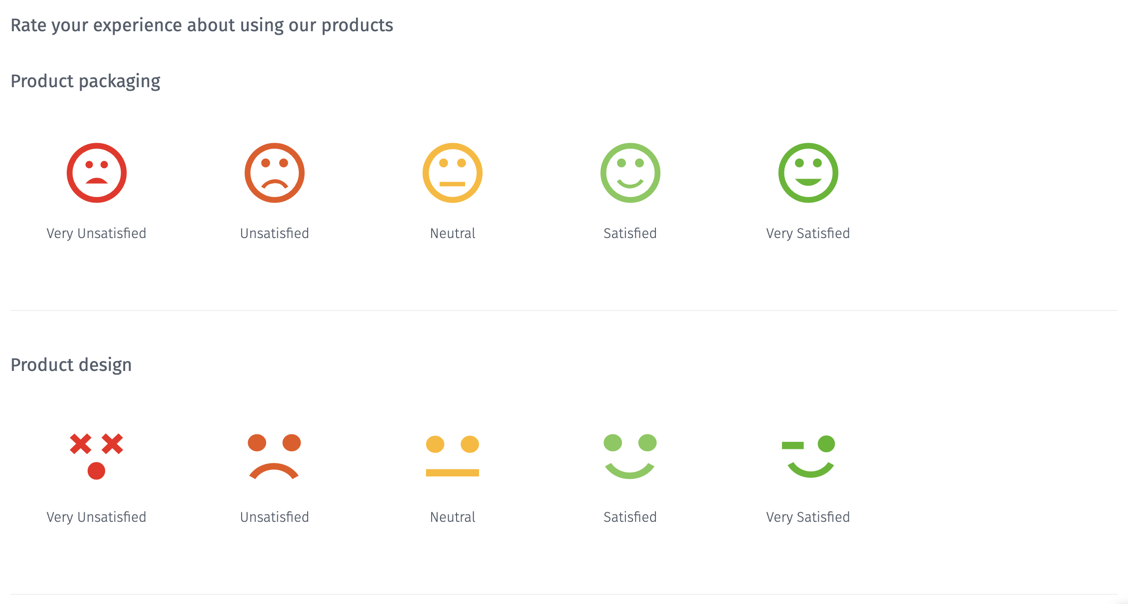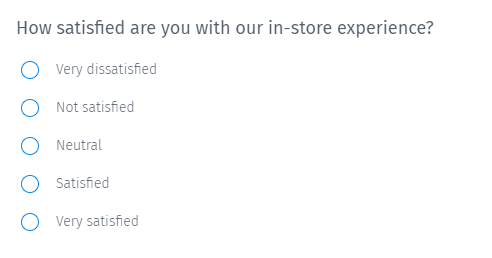Likert scale questions - How it helps measure respondent attitude
The Likert scale question is a psychometric scale where questions based on this scale are used in a survey. It is one of the most widely used question types in a survey. In a Likert scale survey, respondents don't choose between 'yes/no,' there are specific choices based on 'agreeing' or 'disagreeing' on a particular survey question.

Likert scale survey questions are essential in measuring a respondent's opinion or attitude towards a given subject and is an integral part of market research. Likert scale is typically a five, seven, or nine-point agreement scale used to measure respondents' agreement with various statements. Organizational psychologist Rensis Likert developed the Likert Scale to assess the level of agreement or disagreement of a symmetric agree-disagree scale. In general, a series of statements each designed to view a construct from a slightly different perspective is leveraged. This technique's power is that it works across disciplines—it is just as applicable to a social science construct as it is a marketing one.
Measuring customer attitudes with the Likert scale question
Likert scale questions usually have five, seven, or nine points, with five and seven points, used more frequently. For example, typical multiple-choice options include strongly agree, agree, no opinion, disagree, and strongly disagree as to the Likert item. In a Likert survey, adding 'Somewhat' to both sides creates the sixth and seventh points. The scales are anchored by strongly agree and strongly disagree. Some research indicates having the 'agree' side shown first could inflate the scores. This Likert scale data can be tested by alternating the anchor points within a survey wave and comparing ratings in the data analysis stage. The design of the Likert scale question is to measure attitudes that are multi-item. Basic research tells us that a construct's multiple-item measures are inherently more stable and subject to less random variability than single-item measures. How many items are enough? If you are creating a new scale, you should create as many items as possible and let subsequent analysis narrow the contenders' field. These options are achieved through brainstorming sessions, focus groups, or a review of existing literature. Look at the Likert scale samples below for an even better understanding.
Learn more: Likert scale question feature
Likert scale questionnaire and examples
Likert scale questionnaires and question types consist of two question types - unipolar Likert scale and bipolar Likert scale questions. Let us look at the both, below, with examples:
Unipolar Likert scale examples
Unipolar scales are more contoured, allowing users to instead focus on a single item's absence or presence. The scale measures the ordinal data, but most of the time, unipolar scales generate more accurate answers. An example of a unipolar satisfaction scale is: not at all satisfied, slightly satisfied, moderately satisfied, very satisfied, and completely satisfied.

A unipolar Likert scale question type indicates a respondent to think of the presence or absence of quality. For example, a standard unipolar scale includes the following choices: not at all satisfied, slightly satisfied, moderately satisfied, very satisfied, and completely satisfied. The arrangement of the answer options is on a five-point scale. Also, Unipolar question types lend themselves where there is a maximum amount of the attitude or none. For instance, let's say, how helpful was the apple pie recipe? Very helpful, somewhat or not at all. We can safely assume there is something in between – like 'sort of' helpful.
Bipolar Likert scale examples
A bipolar scale indicates a respondent to balance two different qualities, defining the relative proportion of those qualities. Where a unipolar scale has one' pole,' a bipolar scale has two opposites. For example, a common bipolar scale includes the following choices: completely dissatisfied, mostly dissatisfied, somewhat dissatisfied, neither satisfied nor dissatisfied, somewhat satisfied, mostly satisfied, and completely satisfied. That is a scale with 0 in the middle -3, -2, -1, 0, 1, 2, 3.

See an example of bipolar Likert scale questions in our Motivation and buying experience survey template.
Typical Likert scale examples
Let us consider the following statements:
- Ted's Pizza has excellent customer service.
- You get a lot of food for the price at Ted's Pizza.
- People come to me for information on new products.
- I enjoy sharing information with others.
- I consider myself knowledgeable about a variety of issues.
The first two statements measure the customer's perceptions about the business. Traditionally the Net Promoter Score question is used to conduct a customer satisfaction survey. Qualitative research, such as focus groups or in-depth interviews, can help generate a list of statements. The last three comments are centered on the individual and might be part of an opinion leader or early adopter scale. You can easily create a scale with items touching upon political or social topics, religion, or other essential issues.
Learn more about: Likert scale question examples
How to write Likert scale survey questions?
You have seen a few examples of sample survey questions in a likert scale survey. However, following these essential tips in your likert survey would make your likert scale analysis effective and efficient to get the best results. To write likert scale survey questions:
- Be careful about adjectives: In a survey, when you ask the respondent about their opinion, it is essential to precisely keep the response options. Your response options need to include adjectives that are easily understandable. When using attributes in the response option, there should be no confusion in which grade is higher than the other. It is appropriate to start from extremes (Extremely unsatisfied or similar) come to a neutral opinion (neither satisfied nor dissatisfied) and then a positive adjective scale (extremely satisfied or same).
- Using 'Unipolar' or 'Bipolar' Questions: As a survey creator, you should know which Likert questions you want to use. The items are either unipolar questions for positive to negative statements or bipolar questions for answer options lie on either side of neutrality.
- According to a study, it's always better to ask: Human beings respond to questions positively rather than statements; therefore, to gather accurate responses, it is better to ask questions than fabricate statements.
Advantages of Likert scale questions in a survey
The advantages of using likert scale questions in a survey, are:

- Easy to use: Likert scale survey is a universal method of collecting data or information, which means it is easy to understand and respond.
- Easy to report: When the survey creator tends to work around quantitative data, it is easier to communicate the respondents' results.
- Option to answer in the neutral: Since a Likert scale survey involves using a scale, respondents can answer in the neutral if they choose to do so.
- Time-saving survey method: Finally, it's effortless to run these kinds of surveys as they are not time-consuming.
How to use a Likert scale in a QuestionPro survey?
You can set up a Likert scale question and survey in the QuestionPro platform using multiple question types, including multiple-choice select one, rating questions, etc.
Survey Software Easy to use and accessible for everyone. Design, send and analyze online surveys.
Research Suite A suite of enterprise-grade research tools for market research professionals.
Customer Experience Experiences change the world. Deliver the best with our CX management software.
Employee Experience Create the best employee experience and act on real-time data from end to end.








